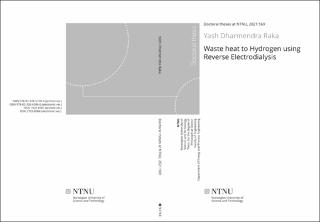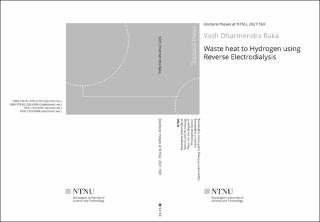| dc.contributor.advisor | Burheim, Odne Stokke | |
| dc.contributor.author | Raka, Yash Dharmendra | |
| dc.date.accessioned | 2021-05-05T08:04:44Z | |
| dc.date.available | 2021-05-05T08:04:44Z | |
| dc.date.issued | 2021 | |
| dc.identifier.isbn | 978-82-326-6386-6 | |
| dc.identifier.issn | 2703-8084 | |
| dc.identifier.uri | https://hdl.handle.net/11250/2753607 | |
| dc.description.abstract | In current times the research across the globe is focused on carbon-free energy sources that can drive the economy in future. One of the promising ways to achieve this is to have demand-based sustainable energy storage powered by renewable energy sources. The use of excess renewable energy to produce chemicals or storing energy in the form of chemicals is the point of focus. This shows that we are transitioning towards power to chemical-based future energy system. Hydrogen is one such chemical. However, renewable energy sources such as solar and wind are intermittent. Sectors such as chemical industries, transportation are found to have potential. More than 40% of the total industrial energy use is being wasted by dumping it in the surrounding. We propose a salinity gradient-based energy system known as Reverse electrodialysis (RED) to solve these problems. Here, the driving force is concentration difference across an ion exchange membrane that causes a flow of ions in a specific direction. This flux of ions can be converted either into electrical current or produce gas such as hydrogen depending on the appropriate choice of electrode-electrolyte system. The RED system does not produce any toxic waste when in operation; it can be up-scaled to Mega-Watts size. Closed-loop RED systems use Mechanical or thermal energy to reuse the solutions exiting from the system. This heat can be at a temperature lower than 373 K. Thus leading to a stand-alone system independent of the geographical constraints for the source of the feed solutions.
A thermolytic salt- ammonium bicarbonate can use the low-grade waste heat (less than 373 K) to restore the concentration to initial. A thermodynamic model developed provides insight into the different parameters such as operating conditions- concentration of feed solutions, temperature; system parameters such as inter-membrane distance or channel thickness; residence time of feed solutions in the RED stack; and membrane properties such as permselectivity and area-specific membrane resistance. The system’s performance is evaluated based on hydrogen production rate normalised over membrane area, waste heat required to produce unit kilograms of hydrogen and cost incurred to produce one kilogram of hydrogen if the system is to be operated for 20 years levelised cost of hydrogen (LCH).
The concentration of concentrate solution increases the hydrogen production rate and reduces the levelised cost of hydrogen. The theoretical maximum concentration of concentrate solution is 2.6 M, whereas, in practice, it is 2M at room temperature. There is an optimal dilute solution concentration; any deviation decreases the hydrogen production rate and increases the levelised cost of hydrogen. However, with the increase in the concentration of feed solutions, the waste heat required to restore the concentration increases. This increase in the waste heat required increases the levelised cost of hydrogen. Hence to achieve low LCH, there is an optimum value of dilute solution concentration. This optimum was found to be ± 0.1 M. The increase in operating temperature increases the open circuit potential, increases ionic mobility, i.e. solution conductivity and thus the hydrogen production and lowers the LCH.
Assuming negligible resistance due to the electrical double layer and diffusion boundary layer, the increase in the inter-membrane distance or channel thickness decrease the hydrogen production rate due to increased channel ohmic resistance. The increase in the intermembrane distance decreases waste heat required per unit volume due to the reduced salt flux through the membrane but increases the total waste heat required due to the increased amount of volume flowing through the channel. An increase in residence time decreases pressure drop and thus the pumping power required. The amount of salt diffusing through the membrane increases, which increases the waste heat per unit volume. However, as the volume flow rate decreases, the total heat required to restore the concentrations decreases.
The economic study suggests that in the present scenario, capital expenses (CAPEX) and waste heat required contributes to more than 75% of the LCH. Regeneration system and membranes contribute more than 80% to the CAPEX. Hence it is essential to optimize regeneration system and membranes to achieve market competitive LCH. In the present and future scenario for a euro increase in the membrane cost, the LCH increases by 0.055 and 0.01 C kg−1 H2 . And for a 0.001 C kWh−1 increase in the cost of waste heat, the LCH increases by 4.02 and 1.78 C kg−1 H2 .
Membrane properties such as permselectivity and membrane resistance of ten commercial membranes were studied. In general, the anion exchange membranes (AEM) showed lower conductivity at different concentration and elevated temperatures when compared to the cation exchange membrane (CEM). The membranes with high conductivity (CMF- CEM; APSAEM) and low area-specific membrane resistance (CSO- CEM; FAS- AEM) were compared based on hydrogen production rate, specific waste heat required, energy efficiency and LCH. The highest performance was achieved with a stack made of FAS and CSO, producing hydrogen at 8.48· 10−7 kgm−2mems−1 with a waste heat requirement of 344kWhkg−1 hydrogen. This yielded an operating energy efficiency of 9.7% and a levelised cost of 7.80 C kg−1H2 . Permselectivity of the best performing membranes was studied at different concentrations; the AEM- FAS had lower permselectivity values than CEM- CSO. The concentration of ammonium bicarbonate solutions in the salt bridge influences the junction potential measurements without any clear trend. The estimated values for hydrogen production rate, thermodynamic efficiency, specific waste heat and the levelised cost of hydrogen for RED stack with CSO/FAS are 8.05·10−7 kgm−2s−1, 9.1%, 365.87kWhkg−1H2 , 10.132 C kg−1 H2 respectively. Finally, membrane area-specific resistance lower than 1·10−4 m−2 and permselectivity higher than 0.9 at membrane cost lower than 10 Cm−2 and waste heat cost of 0.005 CkWh−1 will make ammonium bicarbonate RED competitive with the current renewable source-based hydrogen-producing technologies. | en_US |
| dc.language.iso | eng | en_US |
| dc.publisher | NTNU | en_US |
| dc.relation.ispartofseries | Doctoral theses at NTNU;22021:169 | |
| dc.relation.haspart | Paper 1: Raka, Yash Dharmendra; Karoliussen, Håvard; Lien, Kristian Myklebust; Burheim, Odne Stokke. Opportunities and challenges for thermally driven hydrogen production using reverse electrodialysis system. International Journal of Hydrogen Energy 2020 ;Volum 45.(2) s. 1212-1225. https://doi.org/10.1016/j.ijhydene.2019.05.126
This article is an open access article
distributed under the terms and conditions
of the Creative Commons Attribution
(CC BY) | en_US |
| dc.relation.haspart | Paper 2:
Raka, Yash Dharmendra; Bock, Robert; Lamb, Jacob Joseph; Pollet, Bruno; Burheim, Odne Stokke.
Low-grade waste heat to hydrogen. I: Micro-Optics and Energy: Sensors for Energy Devices. Springer 2020 ISBN 9783030436759. s. 85-114
https://doi.org/10.1007/978-3-030-43676-6_8 | en_US |
| dc.relation.haspart | Paper 3: Raka, Yash Dharmendra; Bock, Robert; Karoliussen, Håvard; Wilhelmsen, Øivind; Burheim, Odne Stokke. The influence of concentration and temperature on the membrane resistance of ion exchange membranes and the levelised cost of hydrogen from reverse electrodialysis with ammonium bicarbonate. Membranes 2021 ;Volum 11.(2) https://doi.org/10.3390/membranes11020135
This article is an open access article
distributed under the terms and conditions
of the Creative Commons Attribution
(CC BY) | en_US |
| dc.relation.haspart | Paper 4:
Raka, Yash Dharmendra; Solberg, Simon Birger Byremo; Bock, Robert; Wilhelmsen, Øivind; Karoliussen, Håvard; Burheim, Odne Stokke.
Permselectivity of IEMs for ammonium bicarbonate- influence of junction potentials and influence of permselectivity on the levelised cost of hydrogen. | en_US |
| dc.title | Waste heat to Hydrogen using Reverse Electrodialysis | en_US |
| dc.type | Doctoral thesis | en_US |
| dc.subject.nsi | VDP::Technology: 500::Environmental engineering: 610 | en_US |

